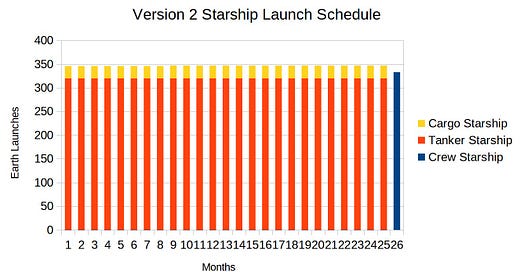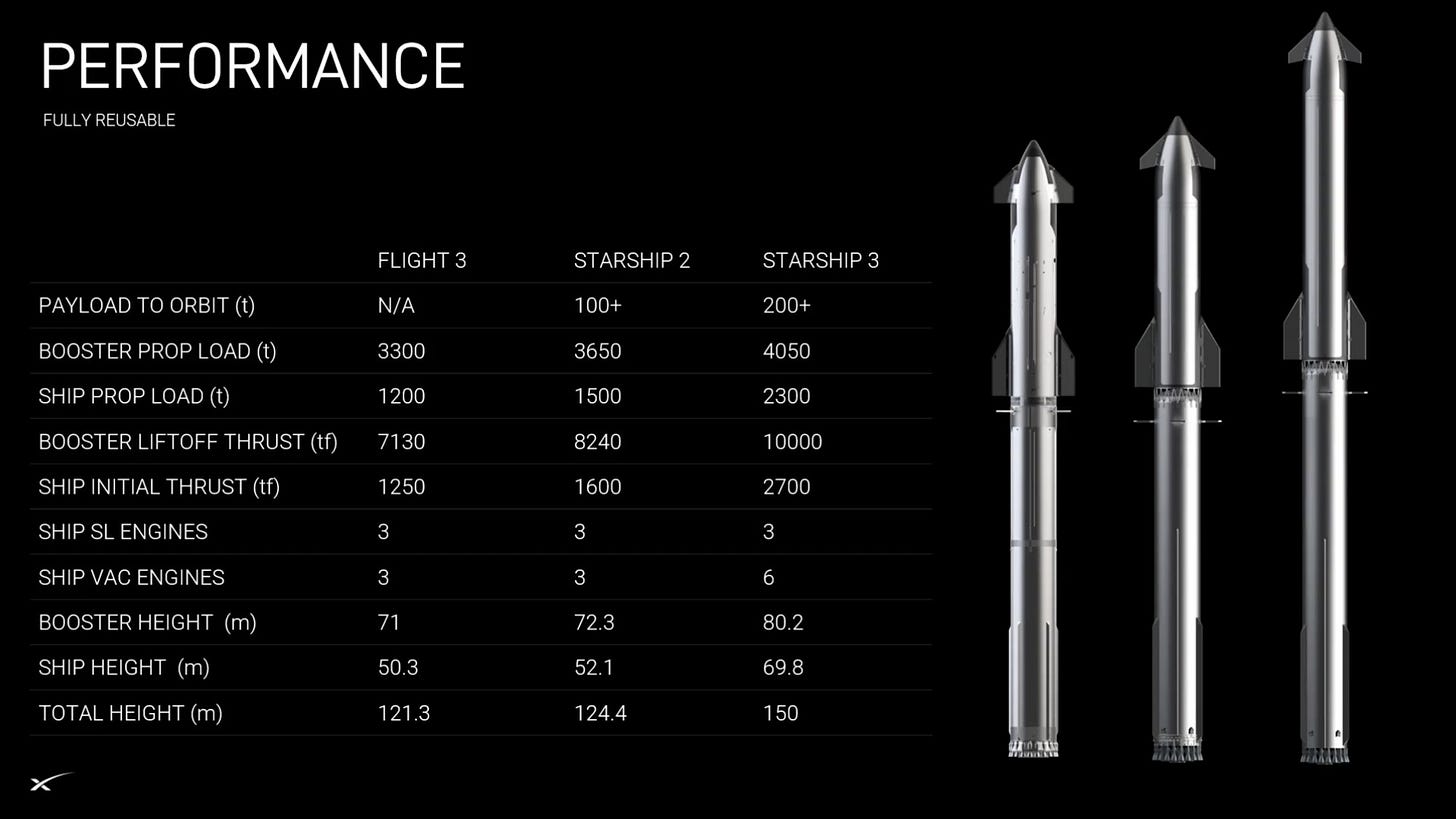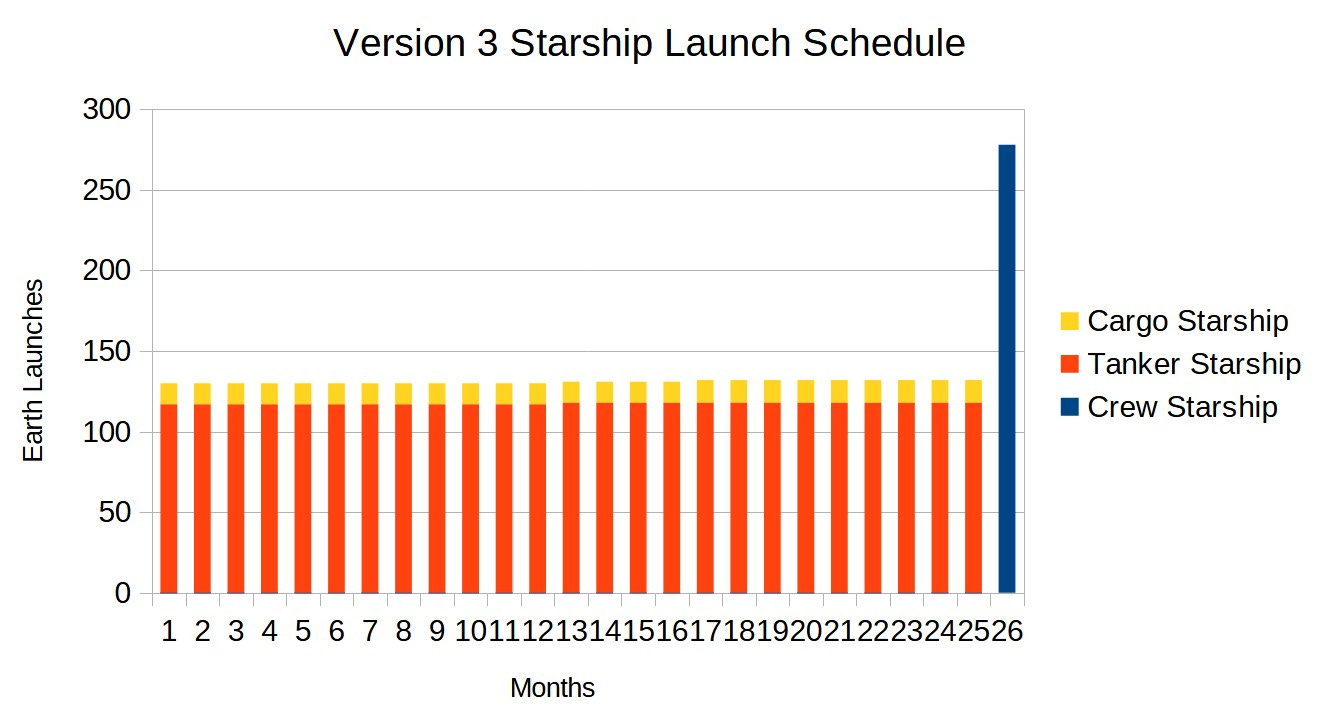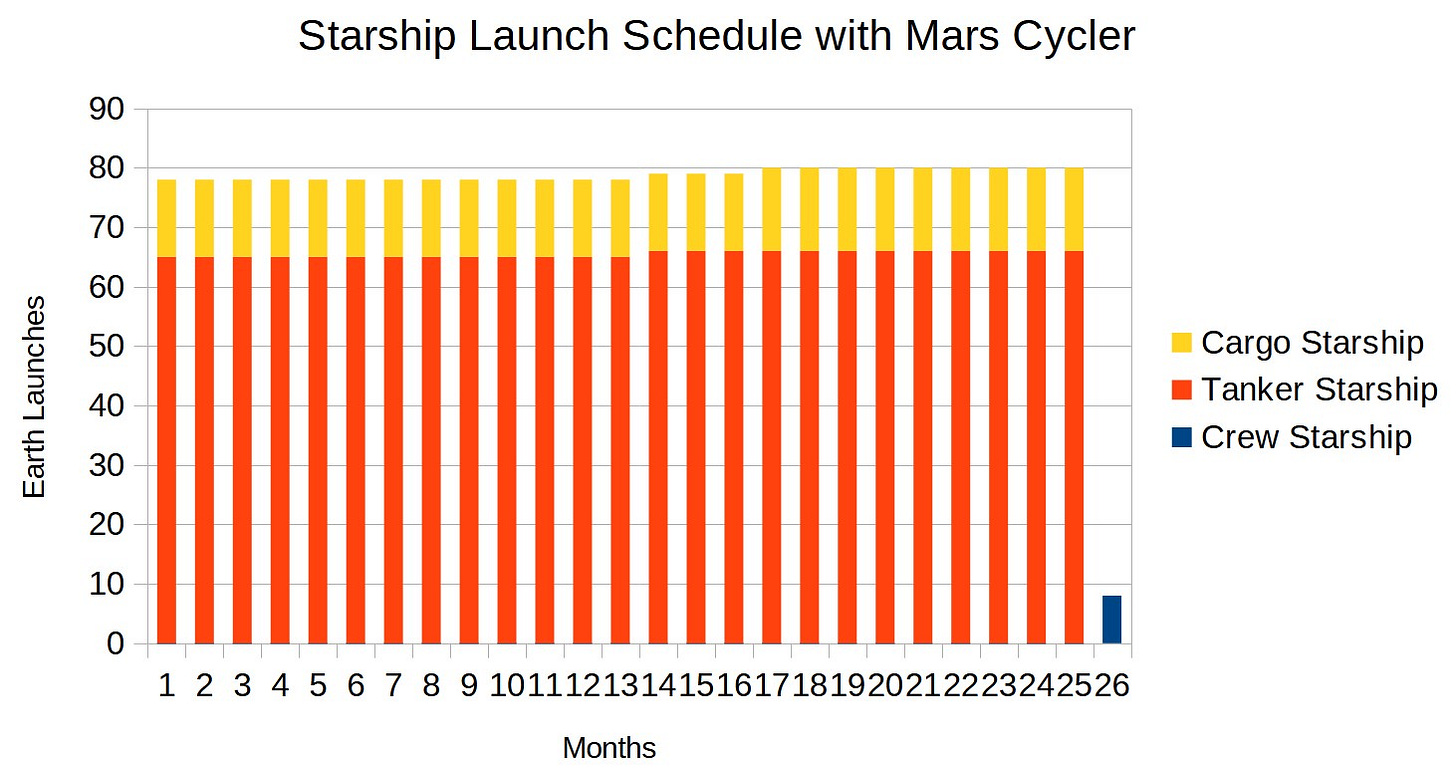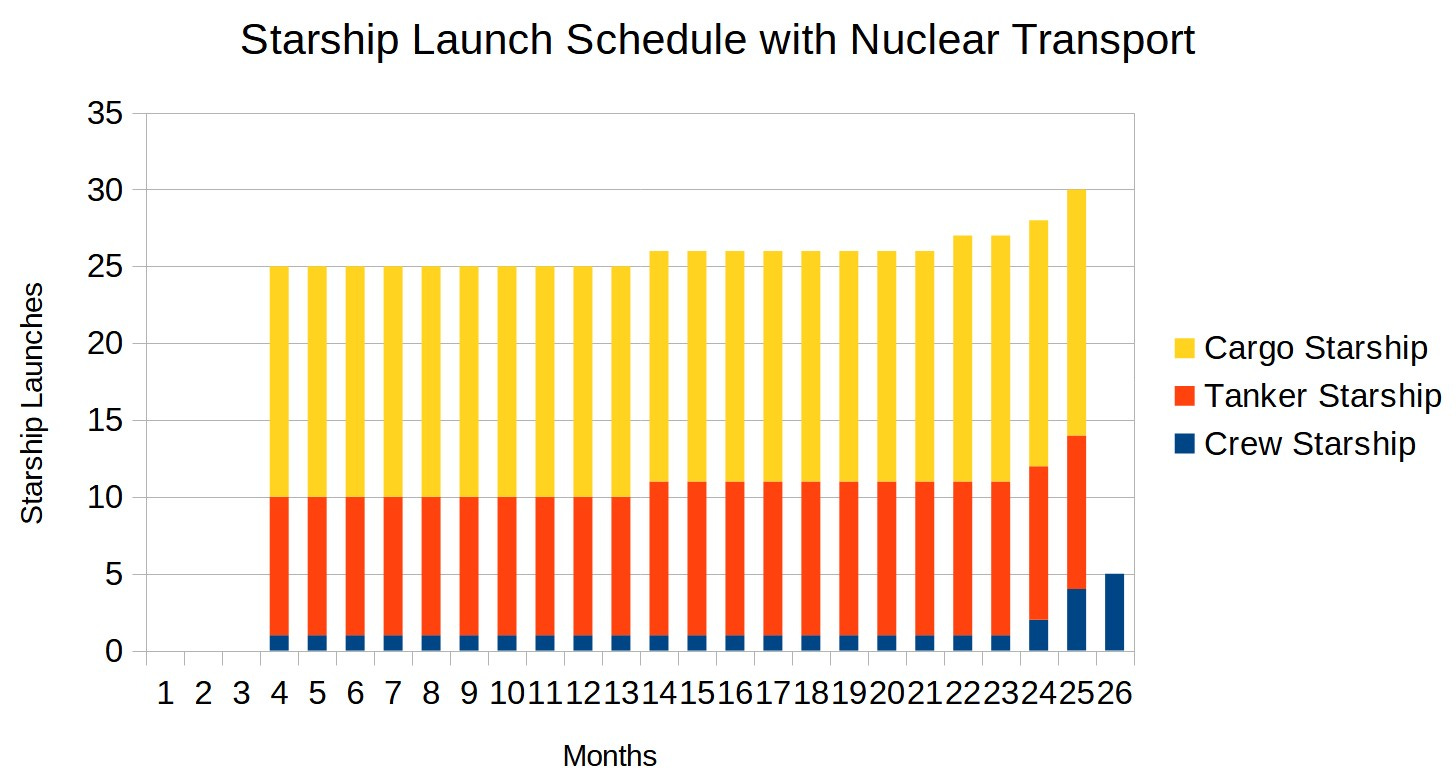SpaceX was founded as a space development company and aim to produce all the space technology needed to colonize Mars. This will require an extraordinarily capable launch vehicle and since inception they have continually increased the size of their vehicles to improve the payload delivered to orbit (i.e. Falcon 1: 0.18t, Falcon 9: 22.8t, Falcon Heavy: 63.8t through to Starship: 100t). Overall this suggests they could develop something even more capable once Starship is operational, to ensure the feasibility of their colonization effort. Currently SpaceX possess a top flight development team who require a continuous supply of fresh work, so it seems unlikely they would risk losing this development capability at such a critical juncture.
Version 2 Starship
SpaceX recently began to construct a Version 2 Starship, which will likely become the first fully reusable, Super Heavy Lift (SHL) launch vehicle. Both stages employ the Raptor 2 engine, arguably the best methalox rocket engine in the world. However, SpaceX are continually improving the technology they produce, including their vehicles and engines.
“Raptor 2 has significant improvements in every way, but a complete design overhaul is necessary for the engine that can actually make life multiplanetary. It won’t be called Raptor.” ~ Elon Musk
This could be interpreted to mean SpaceX intend to continue iteration of their Raptor engine to provide the necessary performance for a practical colonization vehicle. Alternately they could plan to produce a new and more powerful engine to replace the Raptor series entirely. Given how engine performance largely determines a launch vehicles capabilities, an examination of what’s physically required to achieve colonization might be the best way to determine their intent.
Any practical attempt at space colonization, such as establishing a permanent settlement on Mars, will likely require bulk transport of unprecedented scale. Currently SpaceX plan to achieve this by launching 1,000 Starship spacecraft to Mars during the month long Mars launch window (which occurs once every 26 months).
“Building 100 Starships/year gets to 1000 in 10 years or 100 megatons/year [to orbit] or maybe around 100k people per Earth-Mars orbital sync.” ~ Elon Musk
This large fleet of Starships would probably require an additional 1,000 propellant depots to refuel them in orbit, before they depart during the relatively short Mars departure window. Fortunately SpaceX would have 25 months to refill these depots between Mars windows, which will probably require 8,000 launches of their Starship Tanker vehicles. Fortunately these vehicles are designed to be rapidly reusable, which suggests only 20-30 Tankers are actually needed to fully replenish these orbital depots over the interim 25 month period. Overall the original plan provides reasonable redundancy during the early stages of the colonization effort as they ramp-up the number of Starships in operation, but scaling to the 1,000 ship level could prove challenging, for a variety of reasons.
The following bar graph illustrates the number of Starship launches to Earth orbit, during the 26 months between Mars launch windows, excluding any launches required to deploy the orbital propellant depots. Assumes each Tanker Starship can transport 150 tonnes of propellant to orbit (due to reduced dry mass), all Mars bound Starships require 1,200 tonnes of propellant and all Crew Starships are launched during the final month. Maintaining passengers in orbit for any longer would expose them to unnecessary risks, such as: radiation exposure, muscle/bone wastage, and deplete valuable resources required for their Mars voyage (e.g. air, food, water etc). Perhaps a delay of a week or two might be acceptable to prove how each Crew Starship performs in space, any further delay is probably not worth the cost.
Overall the advanced capabilities of Starship (100mt to LEO with full reuse, low operating cost, accelerated production etc.) seem the perfect fit for Mars colonization, except when you consider the practicalities of making life multiplanetary. The equipment and personnel required to elevate Mars to a position where it becomes self-sufficient would be staggering, even if they employ bio-engineering and additive manufacturing to produce goods and machinery in situ on Mars. Unfortunately the fleet which plies between Earth and Mars would also have to accommodate normal commerce, e.g. commodities, luxuries and visitors, in addition to essential colony building materials and personnel. Hence even this ambitious 1,000 ship plan could soon become lacking, due to the ever escalating demand for transport, and difficulty operating such a preponderous number of vehicles. In effect SpaceX will have outgrown Starship.
Given all the above, there’s no substitute for scale, hence SpaceX plans to substantially increase their vehicles’ launch capability, through developing a new and more powerful engine called Raptor 3. Of course in the long-term, there’s certainly some latitude in their approach to scale and nuance within each approach…
Version 3 Starship
The design thrust for the current sea level engine stands at 230t for the Raptor Version 2, however, Elon confirmed they are currently testing a prototype of the next iteration engine, called Raptor Version 3. Once in production, this new engine should produce 280t of thrust, significantly increasing the launch vehicle’s capabilities, effectively making it a new version of Starship. This added performance will allow SpaceX to increase the size of both stages, enabling them to carry more propellant and payload. Hence an up-engined version of the launch vehicle, could give Starship up to 20% more pressurized volume, a key metric when transporting passengers on the 6 month flight to Mars.
The following bar graph assumes Tanker capacity increases to 250t of propellant and cargo capacity increases to 200t. Similarly, the same number of passengers could be transported on 20% fewer Crew Starships, due to the increased pressurized volume.
Unfortunately Starship v3 will still require 278 launches of the crew variant when the Mars window opens in month 26. In addition, these flights carry the most valuable cargo (i.e. people) hence demand significantly more certification work to ensure their safety, likely placing an Atlassian burden on launch staff and infrastructure.
Stretching Starship any farther would seem untenable, it has been designed to launch in most weather conditions but substantially stretching either stage would make the launch vehicle finer and more susceptible to wind shear, (stress caused by differing wind speeds – typically encountered at high altitude). Hence Version 3 will likely become the apex of Starship development, at least with a 9m diameter core…
Starship Heavy
“There will be many versions of BFR [Big Fucking Rocket] as far into the future as we can imagine. People think the size of BFR Version 1 is big. You should see what it looks like when you say: now let’s really optimize the cost per ton to the surface of Mars. You start looking at 1,000 to 1,500 metric tons of payload to the surface of Mars, as opposed to 100 tons with Version 1. So either BFR Version 2 or Version 3 will be aiming for an order of magnitude increase in payload to Mars over BFR [Version] 1.” ~ Elon Musk
To achieve an order of magnitude increase in lift capability SpaceX will have effectively built an entirely new launch vehicle. The first step in the design of any new launch vehicle or spacecraft is to design the engine, because the vehicle attached is effectively built around that engine’s capabilities and requirements. Hence if SpaceX intend to develop a more powerful successor to Raptor, they could use this new engine as the basis for a larger vehicle. Elon Musk has long suggested the next logical step for Starship development is to increase the core diameter from 9 to 18m.
“Probably 18m [diameter] for next gen [launch] system” ~ Elon Musk
On the face of it this should solve many problems, because it would increase the payload mass and volume available by a factor of 4 for the same height vehicle. Hence the number of Starships launched to Mars every 26 month synod could be reduced from 1,000 to 250, certainly a more manageable number. Even if used purely to launch propellant to orbit, Starship Heavy could reduce the number of tanker flights required by at least 3,750 per synod, and eliminate any need for orbital propellant depots.
“Doubling diameter increases mass 4X, but difficulty of simultaneously building & launching rocket of that size is >>4X. In retrospect, <9m diameter for Starship might have been wise. Current size is ~5200 ton stack mass & ~7500 ton-F thrust, which is more than double Saturn V.” ~ Elon Musk
This more recent comment seems to suggest SpaceX are content with a 9m diameter Starship, although it doesn’t specifically rule out the possibility of producing an 18m version at some later date. Notably this comment was posted when SpaceX was undergoing a Programmatic Environmental Review for their Starship development facility at Boca Chica Tx, and had temporarily suspended test flights pending a positive outcome. Under these circumstances it would be understandable if Elon downplayed the possibility of developing an even larger vehicle with potentially greater environmental impact. Currently there is scant evidence they are pursuing anything larger than Starship – except at Cape Canaveral. Reportedly the vertical LOX tank they constructed at LC-39A has an 18m diameter, which could be seen as a test to determine the feasibility of building a propellant tank for an 18m launch vehicle. If they decide to go ahead with this new vehicle, it would likely require a completely new launch complex at the Cape, given the ongoing environmental concerns at Boca Chica.
A conventional 9m diameter Starship has 33 Raptor 2 engines fitted to the booster stage, which suggests an 18m booster might require a staggering 132 engines for optimum reusability. However, if SpaceX manage to field a more powerful engine that would substantially reduce the complexity of an 18m vehicle. Ideally a 4 to 5 times more powerful engine would significantly reduce the engine count and complexity of associated pipework and wiring, bringing an 18m vehicle within the realm of feasibility.
Given the significant upgrade in payload capacity, these launch figures appear far more practical for Starship Heavy, only requiring around 2-3 crew flights per day in busy month 26. However, there are equally ambitious approaches SpaceX might pursue, which build on their existing Starship capability…
Mars Cycler
"...it could turn out that having a [Mars] cycler is a good idea to do. But I consider that to be a future potential optimization, along with having a propellant depot on the moon.” ~ Elon Musk/IAC 2016
SpaceX could use Starship to construct a Mars Cycler, a dedicated space transport platform which is designed to continuously orbit between Earth and Mars every 26 months. Likely this platform would be constructed in Earth orbit to whatever size needed, and could potentially transport all the passengers required each synod. When the planets align, powerful chemical engines would send the platform on an escape trajectory for Mars, and once underway this velocity would be maintained indefinitely, due to conservation of momentum. Thereafter only a small amount of propellant would be needed to put it on the correct slingshot trajectory, adjust small perturbations in its transfer orbit and provide attitude control.
Conventional Starships could be used to shuttle people and propellant to and from the cycler, as it races by each planet. Outgoing Starships would match trajectory with the cycler then dock with the platform for the duration of the interplanetary journey. Upon arrival they would detach and descend to the destination world, while more outgoing Starships head up to dock with the platform. This should significantly reduce the number of Crew Starships required, along with all the ancillary tankers and depots needed to support their operation. Normally Starship could transport 12-24 people to/from Mars in relative comfort, with adequate provision of air, food and water. However, a single Crew Starship could transport 1,000 people to/from a Mars Cycler, if fitted with high capacity seating, similar to a commercial airliner. Around a third of Mars bound Starships will carry people (with the other two thirds carrying fixed volume cargo) so employing a Mars Cycler should reduce the number of passenger Starships required to around 8. In addition a Mars Cycler could operate a closed loop ecosystem to produce its own food, air and potable water, providing far greater comfort for passengers than Crew Starship over the relatively long journey (e.g. Earth to Mars 9 months, Mars to Earth 17 months). The cycler could even provide spin gravity for maximum passenger comfort, and be equipped with effective radiation shielding – all the advantages of space travel with none of the disadvantages.
However, the cycler would only reduce the number of Starships required to transport people, likely they would still need to launch the same number of Cargo Starships, which suggests a cycler might only become a practical alternative after Mars is fully self sufficient. Once Mars can produce all essential goods in situ, only passenger transports to and from Earth would be necessary (with the facility for some luxury cargo), which seems the perfect fit for Mars Cycler’s capabilities.
The following graph assumes Version 3 Starships are used and 5 tanker flights are required to replenish the cycler with propellant per synod.
Unfortunately, there’s an inherent weakness to this approach i.e. the Crew Starships must match velocity and rendezvous with the cycler as it passes by each planet. A 1,000 seat Starship would be designed to travel to the cycler in only a few hours, hence couldn’t support that number of people if it takes days or more to reach the cycler. Fortunately, this kind of scenario seems relatively unlikely because any shortfall in thrust, say from an engine-out, could be overcome by performing a longer burn with the remaining engines. Only a major failure, such as loss of propellant tank pressure or flight control, could seriously prejudice a safe rendezvous.
Nuclear Transport
“We can certainly see a way to get to Mars in under three months and I think ultimately you'll be able to get to Mars in under a month.” ~ Elon Musk/Recode
The final option is to construct a nuclear powered transport in Earth orbit, equipped to carry both passengers and palletized cargo. An advanced nuclear engine, such as a closed cycle gas core, is 14 times more efficient than conventional chemical engines, hence powerful enough to accelerate the whole Transport up to interplanetary velocity then decelerate down to orbital velocity again as it approaches the destination. This powerful platform could be equipped with good radiation shielding (both active and passive), significantly reducing any risk from solar storms.
Again conventional Starships could be used to load and unload the Nuclear Transport in each planet’s orbit, after it completes the 3 month journey from the prior destination. The transport could be steadily unloaded/loaded with cargo in the first 20 months after arrival and embark passengers in the final 3 months prior to departure. This should reduce the number of conventional Starships required to 3 cargo vehicles, 2 passenger vehicles (with high capacity seating), 6 tankers plus eliminate any need for orbital propellant depots.
SpaceX have shown some interest in thermal nuclear engines and generators in the past, despite the inherent difficulty navigating this highly regulated field. However, if SpaceX does plan to use a Nuclear Transport, they are keeping their cards close to their chest. Interestingly Elon made this comment recently to illustrate the potential of an up-engined Starship: -
“50 rockets flying every 3 days on average enables over a megaton of payload to orbit per year – enough to build a self-sustaining city on Mars.” ~ Elon Musk
Overall this suggests they could accumulate over 2 megatons of payload in orbit per synod – but omits to say how this ponderous payload could be transferred to Mars. Certainly it would require a mighty transport platform if sent on one vessel…
Assumes one crew launch per month to rotate the personnel required to operate and train on the Nuclear Transport. Also assumes mass of Transport is comparable to the total dry mass of Version 3 Starships sent per synod, although considerable mass savings could be possible depending on the design of the nuclear vehicle. While the flight schedule still seems relatively unwieldy, this problem would evaporate if SpaceX could employ Starship Heavy, with its 4X payload capacity.
Almost say Starship Heavy was made to service a Nuclear Transport.
In Conclusion
The SpaceX plan to colonize Mars appears ambitious yet feasible if they can increase the efficiency of their transport vehicles beyond the existing Starship capability. Fortunately they are already improving performance of their Raptor engine which should generate ~270t of thrust once fully optimized. This higher thrust capability should increase the vehicle’s payload capacity hence reduce the overall number of colony Starships required from 1,000 down to around 612. Assuming the number of ships that return are relatively small that suggests SpaceX would need to produce ~600 Starships per synod. Manufacturing one Starship a day seems a tall order – except for SpaceX.
"Why can't we build a rocket every day? That's what we're focusing on with Starship, is attacking every part of the production process to be able to build lots of these machines." ~ Gwynne Shotwell/SpaceX COO
Currently SpaceX are building a Starship factory at Boca Chica, which has been designed to exceed this production capacity. However, SpaceX might wish to pursue alternate methods of transport, to lessen the financial burden and strain of operating a fleet of 600+ interplanetary spacecraft. Hence an 18m Starship, Mars Cycler or Nuclear Transport might well enter service before they attain this magic number. Overall a Nuclear Transport appears the ideal solution to overcome their logistics problem. Sourcing the large quantity of nuclear materials required should become less of an issue over the long-term given the US Government’s deepening relationship with SpaceX. Testing too would be relatively easy for SpaceX due to the unique capabilities of Starship. A nuclear powered test bed could be launched onboard Starship then released in deep space, allowing this new technology to be thoroughly tested with little risk to the environment. There seems no appreciable decision yet over how SpaceX plans might unfold but they’ve made no wrong moves so far and, given the strength of their management, that seems unlikely to change in the foreseeable future.
Coming soon to Chris Prophet’s Substack: -
Building the Space Superhighway - how SpaceX will open a cislunar transport network.
If SpaceX discovers life on Mars - potential promise and pitfalls from finding life on Mars.
Space apps enabled by Starship - details the new commercial space applications made possible by Starship.
Managing Mars - laying the foundations for a viable Mars colony.
SpaceX Master Plan - SpaceX strategy to achieve their horizon goal.
SpaceX Paradigm - illustrates how SpaceX are a step evolution in the space business.
And of course continued serialization of “SpaceX Evolution,” an access-all-areas book about SpaceX.

